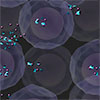| Apr 19, 2022 |
|
(Nanowerk News) Researchers from the Suzhou Institute of Biomedical Engineering and Technology (SIBET) of the Chinese Academy of Sciences and South China University of Technology collaborated to develop a near-infrared (NIR)-driven nanoassemblies with size and charge dual transformation for the combination of photocontrolled chemotherapy and immunotherapy in breast cancer.
|
|
Results were published in Theranostics (“A light-driven dual-nanotransformer with deep tumor penetration for efficient chemo-immunotherapy”).
|
 |
| Nanoassemblies ([email protected]) for NIR-triggered chemo-immunotherapy. (Image: SIBET)
|
|
Nanotechnology has unique advantages in improving the bioavailability of poorly soluble substances, achieving controllable and targeted drug release, and integrating different therapeutic modalities on the same platform.
|
|
However, it faces various biological barriers in practical applications, including blood circulation, trans vascular transport, malformed tumor vessels, and dense tumor extracellular matrix, as a result, most of nanoparticles are mainly localized around the peripheral of the tumor, and it is difficult to penetrate into the tumor to exert cell killing effect.
|
|
In this work, the researchers designed diselenide-bridged mesoporous organosilica nanoparticles as a reactive oxygen species (ROS)-responsive core for the chemotherapeutic agent doxorubicin (DOX) loading. They then coated an indocyanine green (ICG)-hybrid N-isopropyl acrylamide layer to form a thermosensitive shell.
|
|
“The negatively charged thermosensitive layer prevents DOX leakage, rendering prolonged blood circulation time and high tumor accumulation,” said DONG Wenfei from SIBET.
|
|
Upon NIR light irradiation, mild photothermal effects facilitate the dissociation of the thermosensitive shell to achieve negative-to-positive surface charge reversal. Meanwhile, ICG-generated ROS cleave the diselenide bond of the organosilica core, resulting in rapid matrix degradation that produces DOX-containing smaller fragments (115 nm to 20 nm).
|
|
Such an NIR light-driven charge and size dual-transformable nanoassembly facilitates tumor accumulation and deep penetration, enhances chemotherapy efficacy, and induces powerful immunogenic cell death effects in vitro and in vivo.
|
|
In animal studies, combined with programmed cell death protein-1 checkpoint blockade, the nanosystem significantly blocked primary tumor growth and pulmonary metastasis of breast cancer, greatly reducing the toxic side effects of free drugs.
|
|
This study provides a new platform for safe and effective combination therapy for breast cancer. The research team will modify the antibodies on the surface of the nanoassembly to enhance the active targeting of tumors and attempt to use the system to carry gene editing tools for gene therapy of tumors.
|


